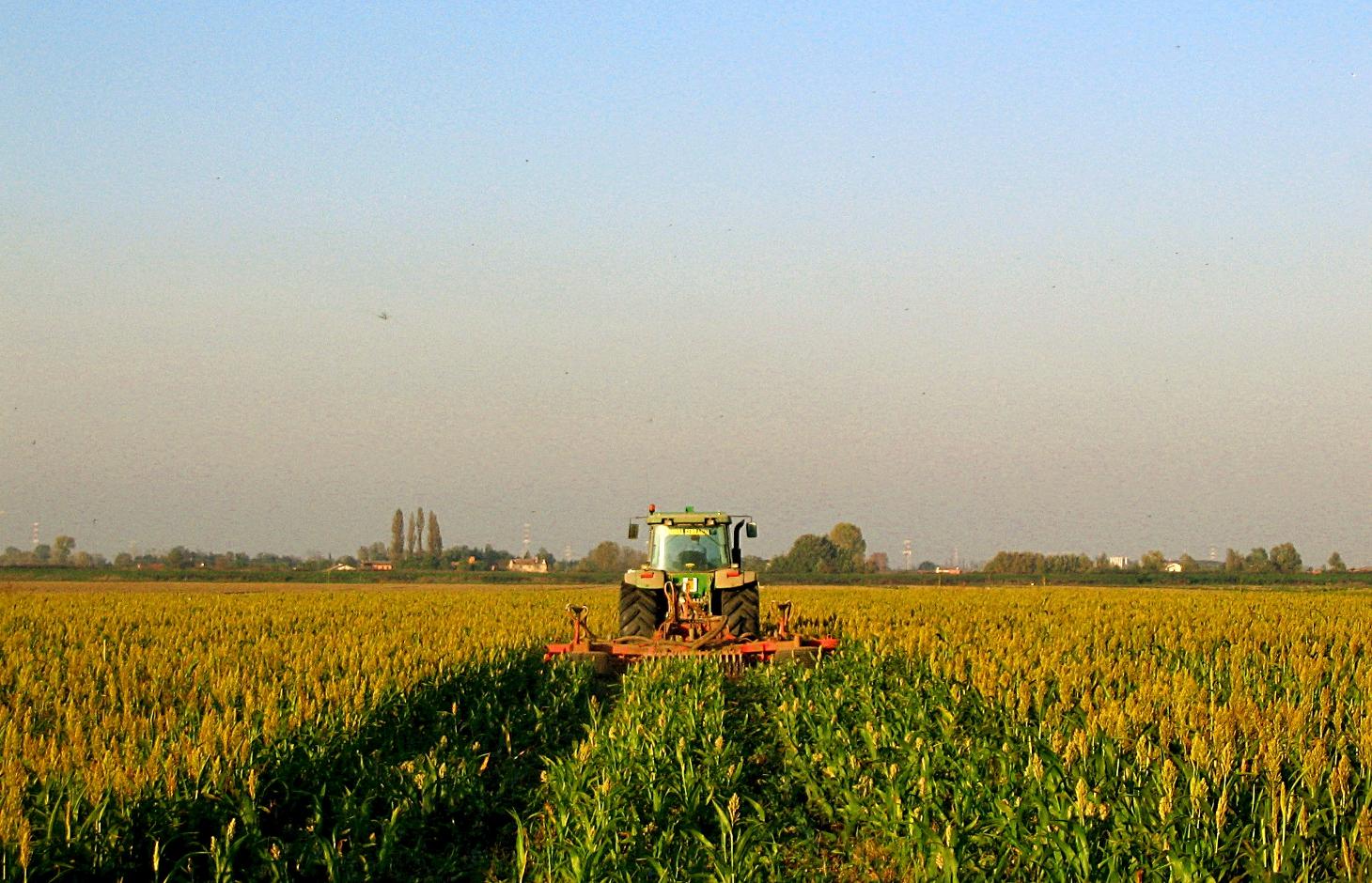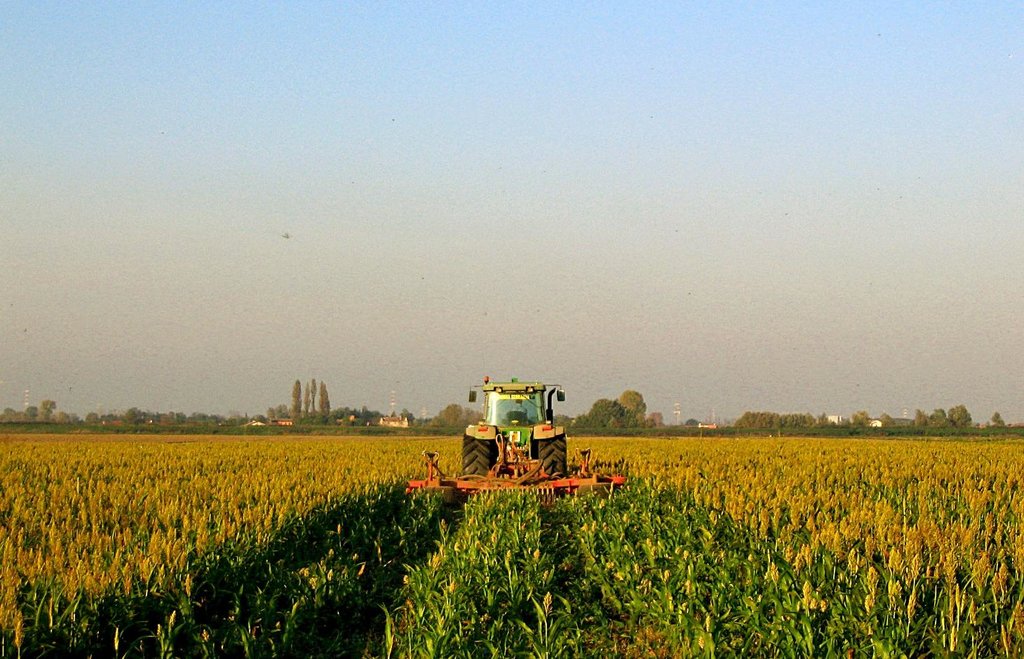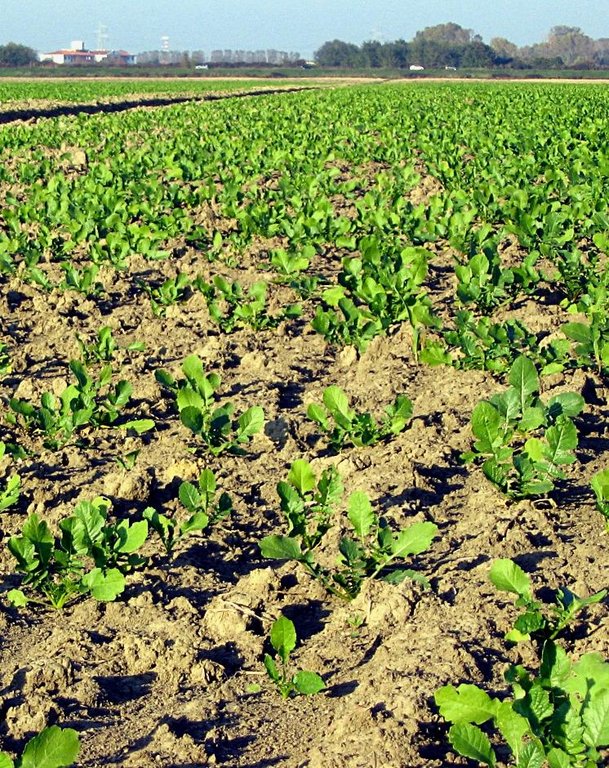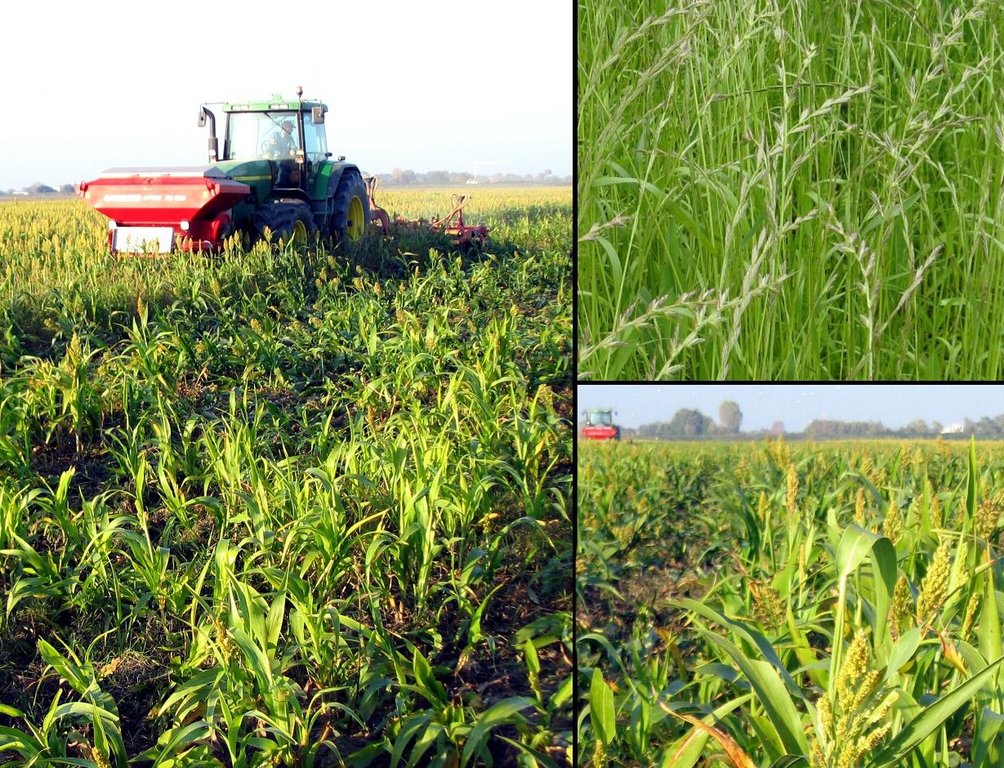Continuous soil cover on croplands [Italy]
- Creation:
- Update:
- Compiler: Nicola Dal Ferro
- Editor: –
- Reviewer: Fabian Ottiger
Copertura continuativa del suolo
technologies_1217 - Italy
View sections
Expand all Collapse all1. General information
1.2 Contact details of resource persons and institutions involved in the assessment and documentation of the Technology
SLM specialist:
Morari Francesco
University of Padova
Via 8 Febbraio 1848, 2, 35122 Padova PD, Italy
Italy
Name of project which facilitated the documentation/ evaluation of the Technology (if relevant)
Preventing and Remediating degradation of soils in Europe through Land Care (EU-RECARE )Name of the institution(s) which facilitated the documentation/ evaluation of the Technology (if relevant)
University of Padova (UNIPD) - Italy1.3 Conditions regarding the use of data documented through WOCAT
When were the data compiled (in the field)?
21/10/2014
The compiler and key resource person(s) accept the conditions regarding the use of data documented through WOCAT:
Ja
1.5 Reference to Questionnaire(s) on SLM Approaches
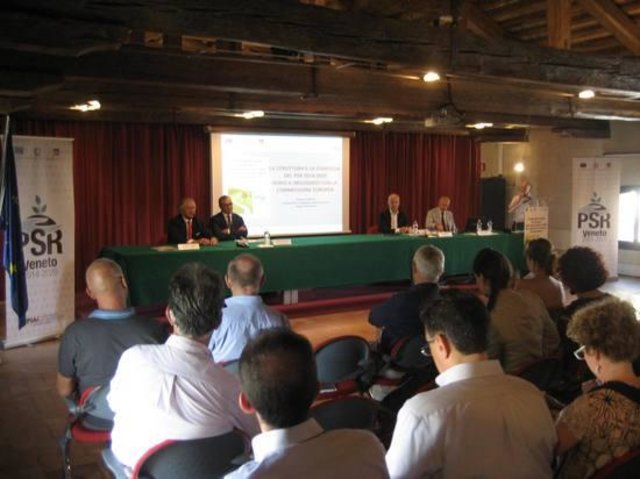
Rural development programme in the Veneto region [Italy]
Developing rural areas in the Veneto region through sustainable land management policies
- Compiler: Nicola Dal Ferro
2. Description of the SLM Technology
2.1 Short description of the Technology
Definition of the Technology:
Maintenance of continuous soil cover; alternating crops and cover crops as a practice to improve soil quality and reduce diffuse agricultural water pollution
2.2 Detailed description of the Technology
Description:
Continuous soil cover on croplands in the Veneto region is characterised by growing seasonal cover crops alternated to the main crop. Continuous cover cropping has been promoted as an agri-environmental measure of the Rural Development Programme (RDP) by Veneto region to extend sustainable land management and reduce diffuse water pollution. Indeed cover crops incorporate available inorganic N that remains within the soil after harvest and reduce water erosion. The type of crop species depends on the crop succession.
Purpose of the Technology: Cover crops have been proposed to the farmers with the aim of reducing environmental impacts of traditional agricultural practices. Compared with systems that does not use cover crops, the continuous soil cover provides long-term agronomical and environmental benefits due to a reduction of negative impacts on agro-ecosystems.
Establishment / maintenance activities and inputs: The application of cover crops involves the alternation of autumn-winter cereals, rapeseed or other herbaceous crops with maize, soybean, sorghum etc. Cover crops that are sown after the main culture are neither fertilized nor treated with pesticides during growing, while at the end of the crop cycle they are buried as green manure in order to improve soil organic matter content, nutrient cycle and finally soil fertility.
Natural / human environment: Growing seasonal cover crops between annual crops have the potential to provide multiple benefits in a cropping system. Cover crops prevent water erosion and pollution as well as increase soil physical properties. Due to the effect of green manure and root growth, cover crops supply nutrients and increase soil organic matter content. They improve soil biodiversity and break pest cycles.
2.3 Photos of the Technology
2.5 Country/ region/ locations where the Technology has been applied and which are covered by this assessment
Country:
Italy
Region/ State/ Province:
Italy
Further specification of location:
Low Venetian plain of Veneto region
2.6 Date of implementation
If precise year is not known, indicate approximate date:
- less than 10 years ago (recently)
2.7 Introduction of the Technology
Specify how the Technology was introduced:
- through projects/ external interventions
3. Classification of the SLM Technology
3.2 Current land use type(s) where the Technology is applied

Cropland
- Annual cropping
Comments:
Major land use problems (compiler’s opinion): Soils in the low Venetian plain of the Veneto region generally suffer from a loss of soil organic matter (SOM) that is strongly affected by their natural texture and climatic conditions. Moreover, in the last 50 years intensive tillage practices contributed to a further SOM decrease, estimated at 0.02-0.58 t/ha/y of carbon. Finally, high intensive agriculture practices increased nonpoint source pollution and in turn caused a decline of surface and groundwater quality.
Major land use problems (land users’ perception): To date, few farmers have adopted voluntarily the continuous soil cover to reduce a decline of soil fertility and water quality, symptom of poor perception of the problem. Adoption of SLT by farmers was sustained only by means of regional subsidies.
3.3 Further information about land use
Water supply for the land on which the Technology is applied:
- mixed rainfed-irrigated
Comments:
Water supply: Also rainfed, full irrigation
Number of growing seasons per year:
- 1
Specify:
Longest growing period in days: 210 Longest growing period from month to month: March to SeptemberSecond longest growing period in days: 180
3.4 SLM group to which the Technology belongs
- improved ground/ vegetation cover
3.5 Spread of the Technology
Specify the spread of the Technology:
- evenly spread over an area
If the Technology is evenly spread over an area, indicate approximate area covered:
- 10-100 km2
3.6 SLM measures comprising the Technology

agronomic measures
- A1: Vegetation/ soil cover
Comments:
Main measures: agronomic measures
Type of agronomic measures: cover cropping, green manure
3.7 Main types of land degradation addressed by the Technology

soil erosion by water
- Wt: loss of topsoil/ surface erosion

chemical soil deterioration
- Cn: fertility decline and reduced organic matter content (not caused by erosion)

biological degradation
- Bc: reduction of vegetation cover
- Bp: increase of pests/ diseases, loss of predators

water degradation
- Hp: decline of surface water quality
Comments:
Main type of degradation addressed: Wt: loss of topsoil / surface erosion, Cn: fertility decline and reduced organic matter content, Bc: reduction of vegetation cover, Hp: decline of surface water quality
Secondary types of degradation addressed: Bp: increase of pests / diseases, loss of predators
Main causes of degradation: soil management (lack of organic input with fertilizations), population pressure (high population density and competition for land)
Secondary causes of degradation: crop management (annual, perennial, tree/shrub) (crop monoculture instead of crop rotation)
3.8 Prevention, reduction, or restoration of land degradation
Specify the goal of the Technology with regard to land degradation:
- prevent land degradation
- reduce land degradation
Comments:
Main goals: mitigation / reduction of land degradation
Secondary goals: prevention of land degradation
4. Technical specifications, implementation activities, inputs, and costs
4.1 Technical drawing of the Technology
4.2 Technical specifications/ explanations of technical drawing
Continuous soil cover is here carried out with direct sowing of ryegrass on a sorghum field. Sorghum was in turn used as cover crop after harvesting of winter wheat.
Location: Low Venetian plain of Veneto region
Technical knowledge required for field staff / advisors: moderate
Technical knowledge required for land users: low
Main technical functions: control of raindrop splash, improvement of ground cover, increase of surface roughness, improvement of water quality, buffering / filtering water
Secondary technical functions: control of dispersed runoff: impede / retard, improvement of surface structure (crusting, sealing), increase in organic matter, increase in nutrient availability (supply, recycling,…), sediment retention / trapping, sediment harvesting
Cover cropping
Material/ species: e.g. barley and vetch, ryegrass, sorghum
Quantity/ density: 35 kg/ha
Green manure
Material/ species: e.g. sudan grass
Quantity/ density: 1.5-6 t/ha
Remarks: Strongly dependant on: 1) type of cover crop; 2) differentiation between summer and winter c.c.
4.3 General information regarding the calculation of inputs and costs
other/ national currency (specify):
Euro €
Indicate exchange rate from USD to local currency (if relevant): 1 USD =:
0.8
Indicate average wage cost of hired labour per day:
21.00
4.4 Establishment activities
Comments:
No initial investment needed
4.6 Maintenance/ recurrent activities
| Activity | Type of measure | Timing/ frequency | |
|---|---|---|---|
| 1. | Cover crops: chopping | Agronomic | |
| 2. | Main crop: seedbed preparation | Agronomic | |
| 3. | Main crop: harrowing | Agronomic | |
| 4. | Main crop: weed control | Agronomic | |
| 5. | Main crop: fertilisation | Agronomic | |
| 6. | Main crop: harvesting | Agronomic | |
| 7. | Cover crops: sowing | Agronomic |
4.7 Costs and inputs needed for maintenance/ recurrent activities (per year)
| Specify input | Unit | Quantity | Costs per Unit | Total costs per input | % of costs borne by land users | |
|---|---|---|---|---|---|---|
| Equipment | Cover crop chopping | ha | 1.0 | 343.0 | 343.0 | |
| Equipment | Main crop: seedbed preparation | ha | 1.0 | 191.0 | 191.0 | |
| Equipment | Main crop: harrowing | ha | 1.0 | 63.0 | 63.0 | |
| Equipment | Main crop: weed control | ha | 1.0 | 44.5 | 44.5 | |
| Equipment | Main crop: harvesting | ha | 1.0 | 152.0 | 152.0 | |
| Equipment | Cover crops: sowing | ha | 1.0 | 121.0 | 121.0 | |
| Plant material | Seeds main crop | ha | 1.0 | 190.5 | 190.5 | |
| Plant material | Seeds cover crop | ha | 1.0 | 191.0 | 191.0 | |
| Fertilizers and biocides | Main crop: fertilisation (fertilizer) | ha | 1.0 | 254.0 | 254.0 | |
| Fertilizers and biocides | Main crop: weed control (biocides) | ha | 1.0 | 125.0 | 125.0 | |
| Total costs for maintenance of the Technology | 1675.0 | |||||
4.8 Most important factors affecting the costs
Describe the most determinate factors affecting the costs:
Although machinery costs are the largest part of total ones, they are almost completely the same for systems adopting - or non adopting - the technology. As a result, additional seeds as cover crop and field labour for sowing are the main costs for implementation of the technology.
5. Natural and human environment
5.1 Climate
Annual rainfall
- < 250 mm
- 251-500 mm
- 501-750 mm
- 751-1,000 mm
- 1,001-1,500 mm
- 1,501-2,000 mm
- 2,001-3,000 mm
- 3,001-4,000 mm
- > 4,000 mm
Agro-climatic zone
- sub-humid
Thermal climate class: temperate
5.2 Topography
Slopes on average:
- flat (0-2%)
- gentle (3-5%)
- moderate (6-10%)
- rolling (11-15%)
- hilly (16-30%)
- steep (31-60%)
- very steep (>60%)
Landforms:
- plateau/plains
- ridges
- mountain slopes
- hill slopes
- footslopes
- valley floors
Altitudinal zone:
- 0-100 m a.s.l.
- 101-500 m a.s.l.
- 501-1,000 m a.s.l.
- 1,001-1,500 m a.s.l.
- 1,501-2,000 m a.s.l.
- 2,001-2,500 m a.s.l.
- 2,501-3,000 m a.s.l.
- 3,001-4,000 m a.s.l.
- > 4,000 m a.s.l.
5.3 Soils
Soil depth on average:
- very shallow (0-20 cm)
- shallow (21-50 cm)
- moderately deep (51-80 cm)
- deep (81-120 cm)
- very deep (> 120 cm)
Soil texture (topsoil):
- coarse/ light (sandy)
- medium (loamy, silty)
Topsoil organic matter:
- medium (1-3%)
- low (<1%)
If available, attach full soil description or specify the available information, e.g. soil type, soil PH/ acidity, Cation Exchange Capacity, nitrogen, salinity etc.
Soil fertility is low-medium
Soil drainage/infiltration is medium
Soil water storage capacity is medium
5.4 Water availability and quality
Ground water table:
< 5 m
Availability of surface water:
good
Water quality (untreated):
good drinking water
Comments and further specifications on water quality and quantity:
Ground water table: <5m (The area surrounding the Venice lagoon (1240 km2) is even below the sea level (down to -2 m) and currently cultivated due to land reclamation. As a result water table is kept artificially low)
Water quality (untreated) is good drinking water (groundwater) or for agricultural use only (surface water)
5.5 Biodiversity
Species diversity:
- medium
Comments and further specifications on biodiversity:
High population density, infrastructures and intensive agriculture practices affect the state of biodiversity.
5.6 Characteristics of land users applying the Technology
Market orientation of production system:
- commercial/ market
Off-farm income:
- less than 10% of all income
Relative level of wealth:
- average
- rich
Individuals or groups:
- individual/ household
Level of mechanization:
- mechanized/ motorized
Indicate other relevant characteristics of the land users:
Land users applying the Technology are mainly common / average land users
Population density: 200-500 persons/km2
Annual population growth: 0.5% - 1%
5% of the land users are rich.
95% of the land users are average wealthy.
5.7 Average area of land owned or leased by land users applying the Technology
- < 0.5 ha
- 0.5-1 ha
- 1-2 ha
- 2-5 ha
- 5-15 ha
- 15-50 ha
- 50-100 ha
- 100-500 ha
- 500-1,000 ha
- 1,000-10,000 ha
- > 10,000 ha
Is this considered small-, medium- or large-scale (referring to local context)?
- medium-scale
5.8 Land ownership, land use rights, and water use rights
Land use rights:
- leased
- individual
5.9 Access to services and infrastructure
health:
- poor
- moderate
- good
education:
- poor
- moderate
- good
technical assistance:
- poor
- moderate
- good
employment (e.g. off-farm):
- poor
- moderate
- good
markets:
- poor
- moderate
- good
energy:
- poor
- moderate
- good
roads and transport:
- poor
- moderate
- good
drinking water and sanitation:
- poor
- moderate
- good
financial services:
- poor
- moderate
- good
6. Impacts and concluding statements
6.1 On-site impacts the Technology has shown
Socio-economic impacts
Production
crop production
Water availability and quality
drinking water availability
irrigation water availability
irrigation water quality
Income and costs
workload
Socio-cultural impacts
national institutions
SLM/ land degradation knowledge
Improved livelihoods and human well-being
Ecological impacts
Water cycle/ runoff
water quality
surface runoff
Soil
soil cover
soil loss
nutrient cycling/ recharge
soil organic matter/ below ground C
Biodiversity: vegetation, animals
biomass/ above ground C
pest/ disease control
6.2 Off-site impacts the Technology has shown
downstream flooding
groundwater/ river pollution
buffering/ filtering capacity
6.3 Exposure and sensitivity of the Technology to gradual climate change and climate-related extremes/ disasters (as perceived by land users)
Gradual climate change
Gradual climate change
| Season | Type of climatic change/ extreme | How does the Technology cope with it? | |
|---|---|---|---|
| annual temperature | increase | not known |
6.4 Cost-benefit analysis
How do the benefits compare with the maintenance/ recurrent costs (from land users' perspective)?
Short-term returns:
slightly negative
Long-term returns:
slightly positive
Comments:
Establishment costs N/A
6.5 Adoption of the Technology
Of all those who have adopted the Technology, how many have did so spontaneously, i.e. without receiving any material incentives/ payments?
- 0-10%
Comments:
100% of land user families have adopted the Technology with external material support
6.7 Strengths/ advantages/ opportunities of the Technology
| Strengths/ advantages/ opportunities in the compiler’s or other key resource person’s view |
|---|
|
Prevents erosion How can they be sustained / enhanced? Maintenance of cover crop |
|
Improves soil fertilty, biodiversity, structure, organic matter content How can they be sustained / enhanced? Usage of organic fertilizations on the main crop |
|
Allows natural control of weeds How can they be sustained / enhanced? Higher seeding rate |
|
Improves knowledge on soil cover benefits and agroecology How can they be sustained / enhanced? Improve farmers' education |
6.8 Weaknesses/ disadvantages/ risks of the Technology and ways of overcoming them
| Weaknesses/ disadvantages/ risks in the land user’s view | How can they be overcome? |
|---|---|
| Increase costs of input and management | Increase awareness on long-term soil benefits and keep subsidies |
| In summer seasons increases the competition for water resources | improve planning and knowledge of suitable species |
7. References and links
7.2 References to available publications
Title, author, year, ISBN:
Programma di sviluppo rurale per il veneto 2007-2013, Regione Veneto, 2007. Dipartimento Agricoltura e Sviluppo Rurale.
Links and modules
Expand all Collapse allLinks

Rural development programme in the Veneto region [Italy]
Developing rural areas in the Veneto region through sustainable land management policies
- Compiler: Nicola Dal Ferro
Modules
No modules


